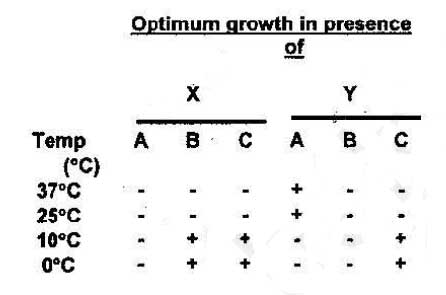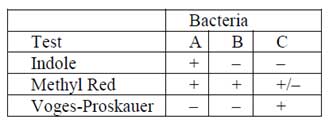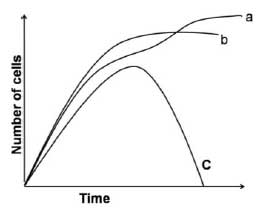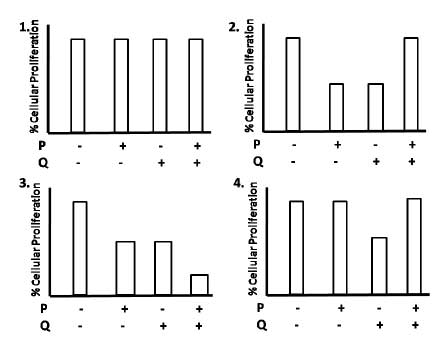Dear Students,
Welcome to MCQ on Microbiology CSIR NET Questions. All these questions were taken from the previous year question papers of CSIR JRF NET Life Sciences Examination. These questions can be used for the preparation of CSIR JRF NET, ICMR JRF, DBT BET JRF, GATE and other University Ph.D Entrance Examinations.
You may also like: Microbiology Notes | Microbiology PPT
(1). To test whether bacteria with enhanced toluene degradative abilities could be created for cold environment, a TOL (toluene-degrading) plasmid form a mesophilic bacterial strain was transferred by conjugation into a facultative psychrophile. The psychrophile was able to degrade salicylate (SAL) but not toluene. The recombinant strain carried the introduced TOL plasmid and its own SAL plasmid. The results are as follows:
Identify A, B, C, X and Y: (CSIR_2015_I)
(a). A. Mesophile; B. Psychrophile; C. Transformant; X. Toluene; Y. Salicylate
(b). A. Mesophile; B. Psychrophile; C. Transformant; X. Salicylate; Y. Toluene
(c). A. Psychrophile; B. Transformant; C. Mesophile; X. Salicylate; Y. Toluene
(d). A. Transformant; B. Psychrophile; C. Mesophile; X. Toluene; Y. Salicylate
Ans. (b)
(2). Satelite RNAs (sat-RNAs) are species of RNA associated with specific strains of some plant RNA viruses, although it is not necessary for their replication.Few statements are given below on sat-RNA
(A). Presence of sat-RNA leads to reduction in severity of disease symptoms.
(B). Presence of sat-RNA leads to increase in severity of disease symptoms
(C). sat-RNA is constitutively expressed like coat proteins and tis independent of virus infection.
(D). sat-RNA is not constitutively expressed like coat proteins but is expressed like coat proteins but is expressed only after virus infection
Which one of the following combinations of above statements regarding sat-RNA is correct? (CSIR_2015_I)
(a). (A) and (B)
(b). (B) and (C)
(c). (C) and (D)
(d). (A) and (D)
Ans. (d)
(3). It takes 40 minutes for a typical E. coli cell to completely replicate its chromosome. Simultaneous to the ongoing replication, 20 minutes of a fresh round of replication is completed before the cell divides. What would be the generation time of E. coli growing at 37⁰C in complex medium? (CSIR_2015_II)
(a). 20 minutes
(b). 40 minutes
(c). 60 minutes
(d). 30 minutes
Ans. (a)
(4). An antibiotic that resembles the 3’end of a charged tRNA molecule is: (CSIR_2015_II)
(a). Streptomycin
(b). Sparsomycin
(c). Puromycin
(d). Tetracycline
Ans. (c)
(5). A culture medium contains two carbon sources, one is preferred carbon source (glucose) and the second is a non-preferred source (lactose). Which one below is correct regarding the nature of growth curve of E. coli cultured in this medium? (CSIR_2015_II)
(a). Growth curve will be same as when grown in presence of only glucose.
(b). Growth curve will be same as when grown in presence of only lactose.
(c). A lag phase will be observed between the two exponential phases.
(d). Two lag phases will be observed between the two exponential phases.
Ans. (c)
(6). A researcher conducts a standard test to identify enteric bacteria (A, B, C) on the basis of their biochemical properties. The result is given in the following table
Based on the above, the identified bacteria A, B and C are most probably (CSIR_2015_II)
(a). Enterobacter, Salmonella, Escherichia.
(b). Escherichia, Salmonella, Enterobacter.
(c). Salmonella, Enterobacter, Escherichia.
(d). Escherichia, Enterobacter, Salmonella.
Ans. (b)
(7). Entry of enveloped viruses into its host cells is mediated by: (CSIR_2016_I)
(a). Only endocytosis
(b). Both endocytosis and phagocytosis
(c). Both endocytosis and membrane fusion
(d). Only pinocytosis
Ans. (c)
(8). Which of the following bacteria has subcellular localization in lysosomes? (CSIR_2016_I)
(a). Salmonella typhi
(b). Streptococcus pneumoniae
(c). Vibrio cholerae
(d). Mycobacterium tuberculosis
Ans. (d)
(9). Which of the following statements is NOT true regarding the closer affinity of Archaea to Eukarya than to Bacteria? (CSIR_2016_I)
(a). Both Archaea and Eukarya lack peptide- glycan in their cell walls.
(b). The initiator amino acid for protein synthesis is methionine in both Archaea and Eukarya.
(c). Histones associated with DNA are absent in both Archaea and Eukarya.
(d). In both Archaea and Eukarya the RNA polymerase is of several kinds.
Ans. (c)
(10). E. coli was grown in three different experimental conditions. In one, it was grown in medium containing glucose as carbon source; in the second in medium containing both glucose and galactose; and in third was infected with phage. Match the curves shown below to the treatment: (CSIR_2016_I)
(a). is grown in glucose; b is grown in glucose and galactose; c is infected with phage
(b). is grown in glucose and galactose; b in glucose; c is infected with phage
(c). is infected with phage; b is grown in glucose and galactose; c in glucose
(d). is infected with phage; b is grown in glucose; c in glucose and galactose
Ans. (b)
(11). Influenza virus (IV), a well known enveloped animal virus, enters its host cells through membrane fusion process catalyzed by haemagluttinin (HA) protein inside endosomes at 37⁰C. HA is localized in the lipid bilayer membrane of the IV as an integral membrane protein and is responsible for binding and fusion of IV membrane with the endosomal membrane of host cells. Upon binding, IV is internalized into host cells through receptor mediated endocytosis followed by fusion of the IV membrane with endosome membrane catalyzed by HA. In a situation, if we wish to fuse IV membrane with its host cells (deficient in endocytosis) at the plasma membrane, mention the correct condition out of the following: (CSIR_2016_I)
(a). Pre-treat IV in pH 5.0 followed by its binding and fusion with host cells at pH 7.4 and 37⁰C.
(b). Allow the IV to bind and fuse with host cells at pH 7.4 and 37⁰C.
(c). IV and host cells are allowed to bind and fuse at pH 5.0 and 37⁰C.
(d). IV is subjected to incubation at 60⁰C for 30 minutes and allowed to bind and fuse with host cells at pH 5.0 and 37⁰C.
Ans. (c)
(12). A virus infects a particular cell type, integrates its genome into a site that contains a proto-oncogene, transforms the cell and increases the level of a protein ‘X’, which increases cellular proliferation. A compound ‘P’ is known to increase the level of tumor suppressor proteins in that cell type whereas a compound ‘Q’ helps in stimulating a protein ‘Z’ that can bind to ‘X’ rendering it inactive. Which one of the following graphs correctly represents the mode of action of ‘P’ and ‘Q’? (CSIR_2016_I)
(a). Graph 1
(b). Graph 2
(c). Graph 3
(d). Graph 4
Ans. (c)
(13). Five bacterial markers were followed for a co-transduction experiment. The following table documents the observations of this experiment. ‘+’ denotes co-transduction and ‘-’denotes lack thereof; ‘ND’ stands for not determined. (CSIR_2016_I)
Pick the correct order in which the genes are arranged on the bacterial chromosome
(a). str – gal – leu – arg – met
(b). leu – met – arg – str – gal
(c). leu – str – met – gal – arg
(d). arg – gal – str – leu – met
Ans. (d)
(14). One of the mechanisms used by bacteria for adaptation to changed environment is altering transcription of their genes. In this regard, which one of the following responses is NOT found in bacteria? (CSIR_2017_II)
(a). A gene with two different promoters for expression in different conditions
(b). Use of different sigma factors for transcription of genes
(c). Expression of alternate α, β and βʹ subunits
(d). Expression of anti-sigma factors
Ans. (c)
(15). Which one of the following λ proteins acts both as an activator and repressor of transcription? (CSIR_2017_II)
(a). cI protein
(b). N protein
(c). cII protein
(d). Q- protein
Ans. (a)





